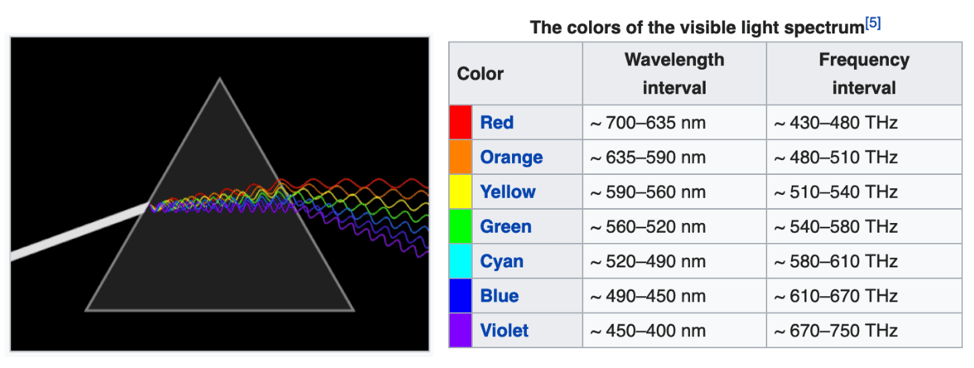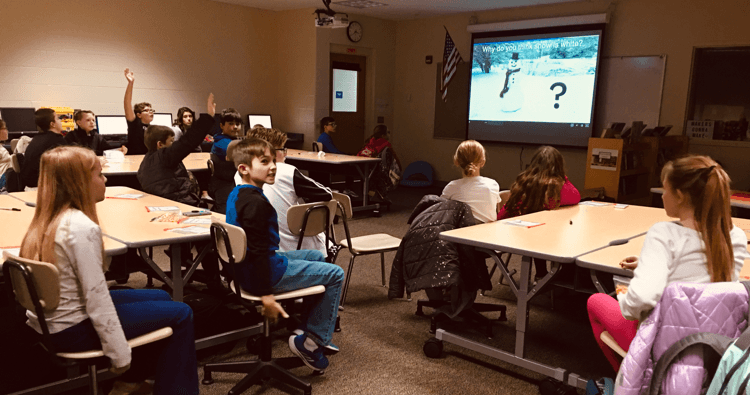By: Meghan Thoreau, OSU Extension Educator
(Short video highlight at the bottom!)
This past December students explored a variety of science and engineering principles. First, they learned more about the science of color and why snow is generally white in color, as well as engaged in hands-on activities that looked at gravity and contact and non-contact forces as well as shared in group discussions on how these forces can impact engineering and construction designs.
Why is snow white?
This is a timely winter question for our young STEMist. Having a “white” blanketed landscape is a common picturesque image conjured up during the winter months – it supports many winter activities such as sledding, snowman building, and backyard snow fort construction.
The students had some probing discussions and watched a short video from our favorite online science teacher, Doug Peltz, in his ‘Mystery Doug’ video science series. The students learned that color is determined by visible light and the particular particles of objects themselves.
 Photo source: https://en.wikipedia.org/wiki/Color
Photo source: https://en.wikipedia.org/wiki/Color
The world is made up of many different objects that have many different combinations of atoms and molecules which vibrate at different frequencies that our eyes see as different colors. Snow is no different, it’s a collection of vibrating particles, but the way snow is made gives its particles a layering effect to consider when thinking about the answer.
Sounds complicated? First, the students considered what snow is made of – frozen water – and that water is clear, all things considered, so something happens when water freezes. Snow is made up of many different tiny pieces of ice particles and ice is not transparent or clear, it’s actually translucent. This is because ice particles are layered on top each other, and therefore, light can’t pass straight through, but is redirected in many different directions. The students took a snow making take home project to emphasize the layering translucent effect that creates a white snowflake ornament.
Photo source: https://www.open.edu/openlearn/science-maths-technology/introduction-minerals-and-rocks-under-the-microscope/content-section-0
Light is scattered and bounces off the ice crystals in the snow. The reflected light includes all the colors, which, together, looks white. In some unusual situation depending on the surrounding light sources and frequencies of objects, snow can take a hint of yellow or purplish glow color from its normal bright white color.
Moving from color science to physics and force
What is a force?
Force is an agent which accelerates a body. The students learned a force is a push or a pull of one object on another object, but both objects have to be interacting with each other.
 Image source: http://learntogethersim.blogspot.com/2017/07/what-is-force.html
Image source: http://learntogethersim.blogspot.com/2017/07/what-is-force.html
Gravity is a pulling force that acts between two things (such as a person’s body and the mass of the earth) but its effect depends on the mass and distance between the objects being pulled together. It was also fascinating for the students to learn that force doesn’t produce motion necessarily, but rather adds acceleration. Additionally, all objects have a center of mass or a center of gravity that impacts movement in accordance to the laws of physics. We decided to challenge the students further by having them consider objects and people launched into outer space with the forces of physics at play.
Image source: https://www.wired.com/2010/10/why-do-we-launch-rockets-from-cape-canaveral/
We shared a Big Think video from Michelle Thaller, Assistant Director for Science Community at NASA, Why Zero Gravity is a Myth. Thaller broke down rocket science concepts and misconceptions about gravity in outer space. Many people think astronauts in space are weightless and floating because there is zero gravity. To better understand the forces at hand, Thaller asked her viewers to consider the space station orbiting earth 200 miles away, completing an orbit once every 90 minutes. (Pretty amazing when you realize earth’s circumference is around 24,900 miles.)
The astronauts inside are not exactly weightless. In fact, the astronauts probably weigh 80 percent of their earth body weight and are still close enough to earth to feel earth’s gravitational pull. Scientists have to use powerful rockets that blast off into space with incredible speeds to reach the distance to orbit earth. The floating effect is achieved by understanding how the objects and people are launched into space at these high velocities, shooting around the earth at extreme speed, while simultaneously being pulled down by earth’s gravity.
The space station, for example, is moving around 17,000 mph and the astronauts inside are actually free falling down to the surface of the earth by the pull of gravity, like a falling ball launched from a cannon. Because the astronauts are also orbiting so fast forward, they actually continue to miss the earth as they fall with the pull of gravity, which in turn gives them the floating effect we associate with outer space images and video clips. That concept of traveling at extreme speeds while free falling and continually missing your target is the definition of an orbit.
The students applied some new physics concepts and experimented with hands-on forces and center of gravity challenges in STEM Club; forces of frictional, normal, and tension force challenges. Here’s a short video that highlights a few of our STEM Challenges.



